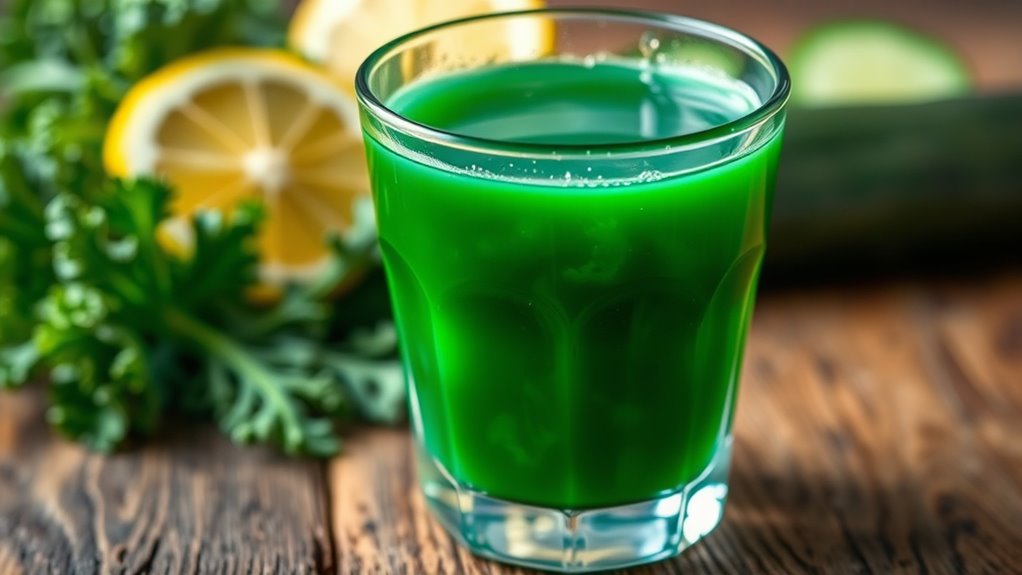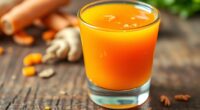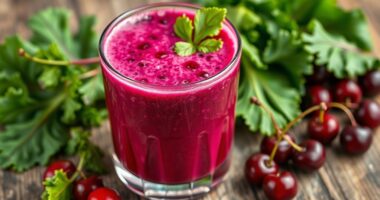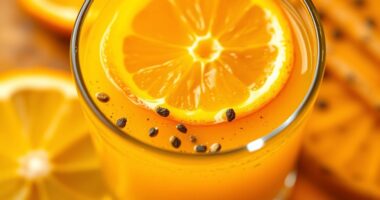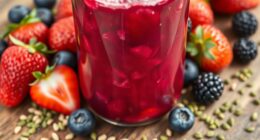To spot hidden sugars in “healthy” green juices fast, check labels for terms like honey, agave syrup, or fruit concentrates, which hide added sugars. Look beyond the front marketing — ingredients ending in “-ose” or names like apple juice concentrate reveal extra sweetness. Be aware that processed concentrates and natural sugars from fruit can be misleading. With a quick glance, you can identify these sneaky ingredients and make better choices—discover more tips to stay sugar-smart as you go.
Key Takeaways
- Check ingredient labels for hidden sugars like agave syrup, honey, or fruit concentrates, which are often disguised as natural ingredients.
- Look for terms ending in “-ose” (glucose, dextrose) or artificial sweeteners like sucralose or acesulfame potassium.
- Be wary of fruit juices and concentrates labeled as “natural” or “flavor,” indicating added sugars or processed ingredients.
- Prefer whole greens or homemade juices without added sweeteners to avoid hidden sugars altogether.
- Quickly scan labels for common sweetener names and avoid products with multiple or ambiguous sugar-related ingredients.
Common Names for Hidden Sugars in Juices
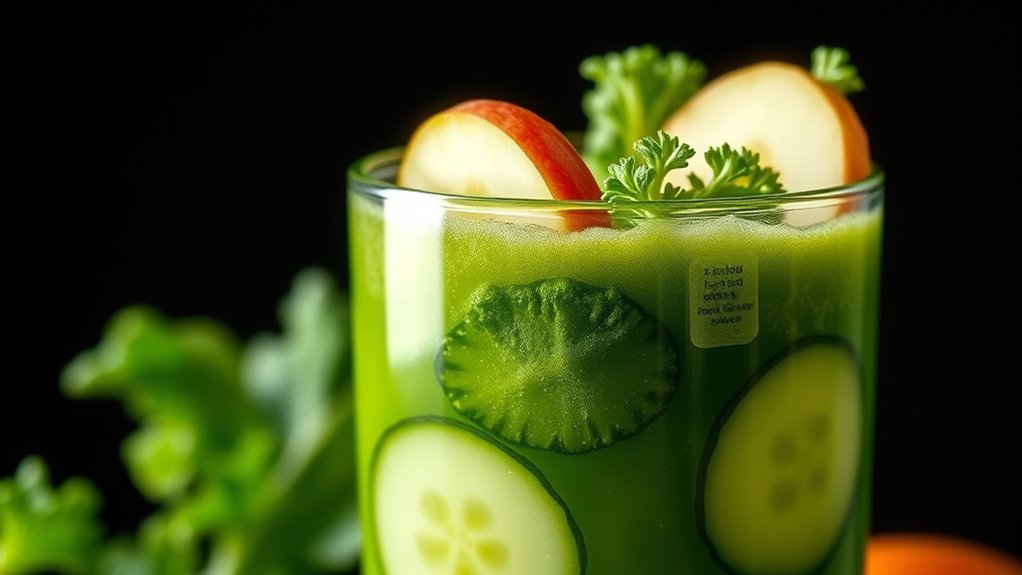
Many people don’t realize that added sugars in green juices often go by different names on ingredient labels. You might see fruit derived thickeners like agave syrup, honey, or apple juice concentrate, which are sources of natural sugars but still contribute calories. Additionally, manufacturers often use artificial sweetener names that aren’t immediately obvious, such as aspartame, sucralose, or acesulfame potassium. These ingredients are added to enhance sweetness without adding visible sugar, making it tricky to identify hidden sugars at a glance. Being aware of these names helps you better understand what you’re consuming. Always check ingredient labels carefully, and remember that even “healthy” green juices can contain these hidden sweeteners, which can spike blood sugar and undermine your health goals.
Recognizing Sweeteners on Ingredient Labels
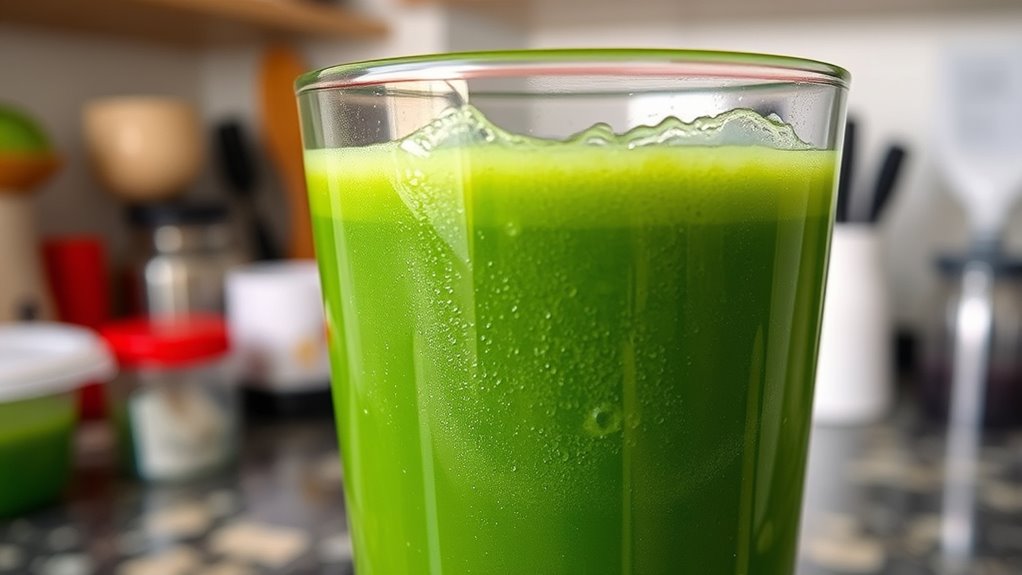
Knowing what to look for on ingredient labels can help you identify hidden sweeteners in green juices. Many products use sweetener alternatives that aren’t obvious, so label decoding is essential. Look beyond sugar and honey; companies often list ingredients like agave syrup, cane juice, or brown rice syrup, which are hidden sources of added sugars. Artificial sweeteners like aspartame or sucralose may also be present, sometimes disguised under names like acesulfame potassium. Check for less familiar terms, and be wary of ingredients ending in “-ose,” such as glucose or dextrose. Additionally, understanding product transparency can be helpful in other areas of visual quality, emphasizing the importance of detailed product knowledge. Recognizing sweetener alternatives can help you better distinguish between natural and added sugars, ensuring you make healthier choices. Being aware of label terminology can further equip you to spot hidden sugars quickly. By learning to recognize these hidden sweetener options, you can make more informed choices and avoid unintentionally consuming excess sugars, even in “healthy” green juices.
The Role of Fruit Concentrates and Juices

Fruit concentrates and juices often undergo processing techniques that can hide added sugars. These methods can concentrate natural sugars, making the final product much sweeter than you might expect. Understanding how these processes work can help you spot hidden sugars in green juices. Additionally, many products incorporate vintage decor and rustic elements to appeal to consumers seeking a wholesome image, which can sometimes mask the actual sugar content.
Concentrate Processing Techniques
Concentrate processing techniques play a significant role in shaping the sugar content of green juices, often adding hidden sugars through the use of fruit concentrates and juices. During concentrate processing, fruit is crushed and heated to remove water, resulting in a concentrated syrup that retains much of its natural sugar. Juice extractors then rehydrate these concentrates, which can add sweetness without your knowledge. Many manufacturers use this method to enhance flavor and shelf life, making their products seem natural while actually increasing sugar levels. When shopping, look at ingredient lists for terms like “fruit concentrate” or “fruit juice,” which indicate concentrate processing. Being aware of how these techniques work helps you spot hidden sugars and choose greener, healthier options.
Hidden Sugar Content
While concentrate processing techniques can boost flavor and shelf life, they also contribute to hidden sugars in green juices. Many manufacturers add fruit concentrates or juices to enhance sweetness, often without clear labeling. These concentrates contain high levels of natural sugars, which can be masked as “fruit juice” or “natural flavor,” making it hard to spot. Some products replace sugar with artificial sweeteners or sugar alcohols, claiming to be healthier, but these can still impact blood sugar levels or cause digestive issues. Be cautious, as these added ingredients may not be obvious on labels. Always check ingredient lists carefully—look for terms like “fruit concentrate” or “artificial sweeteners”—to avoid consuming hidden sugars disguised as healthy ingredients. Additionally, understanding glycolic acid products can help you better identify ingredients that may be used in skin or hair care to improve appearance without unnecessary additives. Recognizing natural sweeteners in ingredient lists can further aid in making healthier choices. Being aware of hidden sugars in processed foods is essential for maintaining a balanced diet and health. Manufacturers often use deceptive labeling practices to hide added sugars, so vigilance is key.
Natural vs. Added Sugars: What’s the Difference?
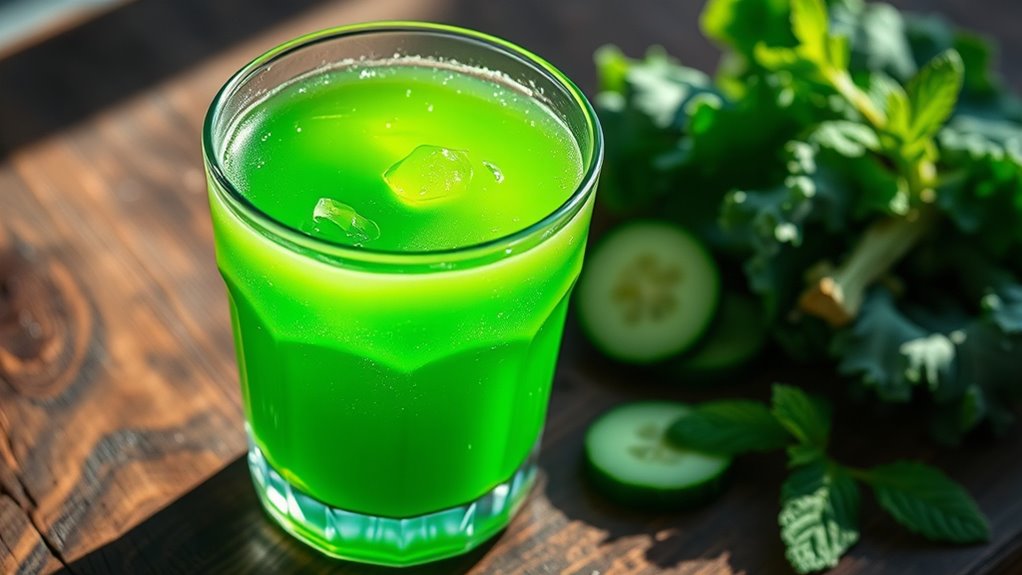
Have you ever wondered what separates natural sugars from added sugars in green juices? Natural sugars, found in fruits and vegetables, are part of the food’s original structure, meaning your body processes them more gradually. This steady sugar metabolism helps prevent blood sugar spikes and supports sustained energy. In contrast, added sugars are added during processing or preparation, often in large amounts, and can lead to quick energy crashes and increased health risks over time. Consuming too many added sugars may contribute to weight gain, insulin resistance, and other health implications. Recognizing the difference is key to making smarter choices, especially when selecting green juices labeled as “healthy.” By understanding natural versus added sugars, you can better control your sugar intake and promote overall well-being.
Tips for Choosing Low-Sugar or No-Sugar Green Juices
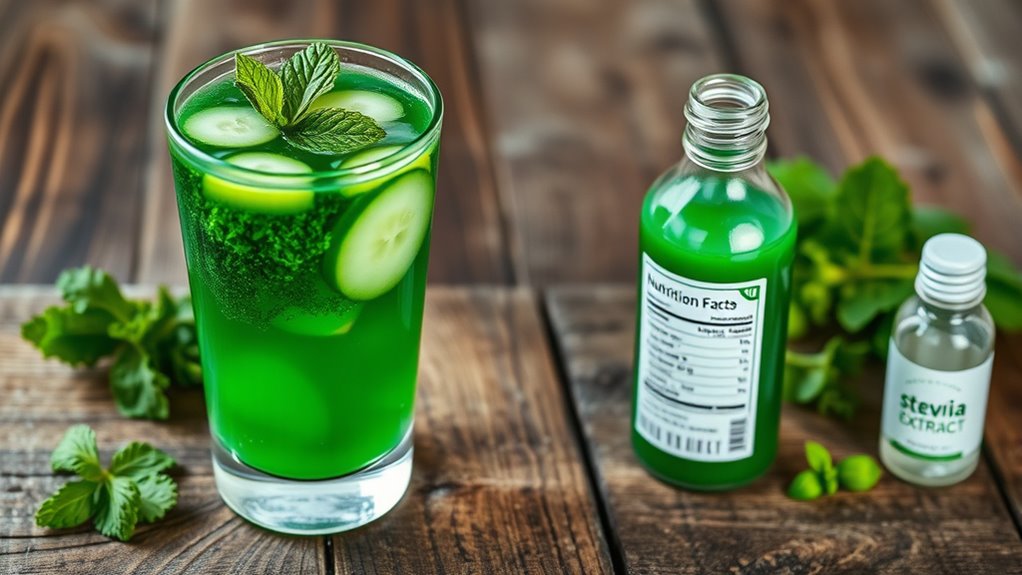
When selecting green juices, reading labels carefully helps you spot hidden sugars. Look for options that list whole greens or vegetables as the main ingredients rather than added sweeteners. Whenever possible, choose juices made from whole greens to make certain you’re getting fiber and fewer sugars. Being aware of the brewing techniques used can also give insight into whether a juice contains added sugars or flavorings. Additionally, understanding Fokos can provide insights into how different preparation methods may influence the sugar content in green juices. Incorporating knowledge from Gold IRA Rollovers about diversification can also remind consumers to diversify their beverage choices and reduce reliance on potentially sugar-laden drinks. Recognizing Free Floating sugars that are not bound to other molecules can help in choosing juices with minimal added or hidden sugars.
Read Labels Carefully
To find green juices with little or no added sugar, you need to read labels carefully. Label reading is key to spotting hidden sugars and understanding what’s truly in your juice. Pay close attention to the ingredient list—ingredients are listed in order of quantity, so if sugar or sweeteners appear early, the drink is likely high in sugar. Develop ingredient awareness to recognize less obvious names for sugars, like syrup, concentrate, or fruit juice from concentrate. Always check the nutrition label for added sugars, which can be hidden under different names. Being familiar with digital literacy can help you better interpret labels and identify misleading marketing claims. Additionally, understanding food labeling regulations can empower you to make more informed choices and avoid deceptive packaging. Familiarity with label terminology helps you quickly identify hidden additives that may not be obvious at first glance. Recognizing marketing tactics used by brands can prevent you from being misled by health claims. By taking a few seconds to scrutinize labels, you can easily identify options with minimal or no added sugars, helping you make smarter, healthier choices for your green juice.
Opt for Whole Greens
Choosing whole greens over processed juices is one of the best ways to keep your sugar intake low. Whole greens, like spinach, kale, and celery, have minimal natural sugars and retain fiber that helps regulate blood sugar levels. When shopping, avoid juices loaded with plant based sweeteners or sugar alternatives, which can mask added sugars. Instead, focus on fresh, whole greens or make your own juice at home. If you prefer a slightly sweet flavor, add a small piece of fruit or a dash of lemon instead of relying on sugar substitutes. This way, you control what goes into your drink and avoid hidden sugars. Opting for whole greens ensures you get maximum nutrients without unnecessary added sugars, supporting better health and sustained energy.
Quick Tricks to Spot Sugary Additions in Seconds
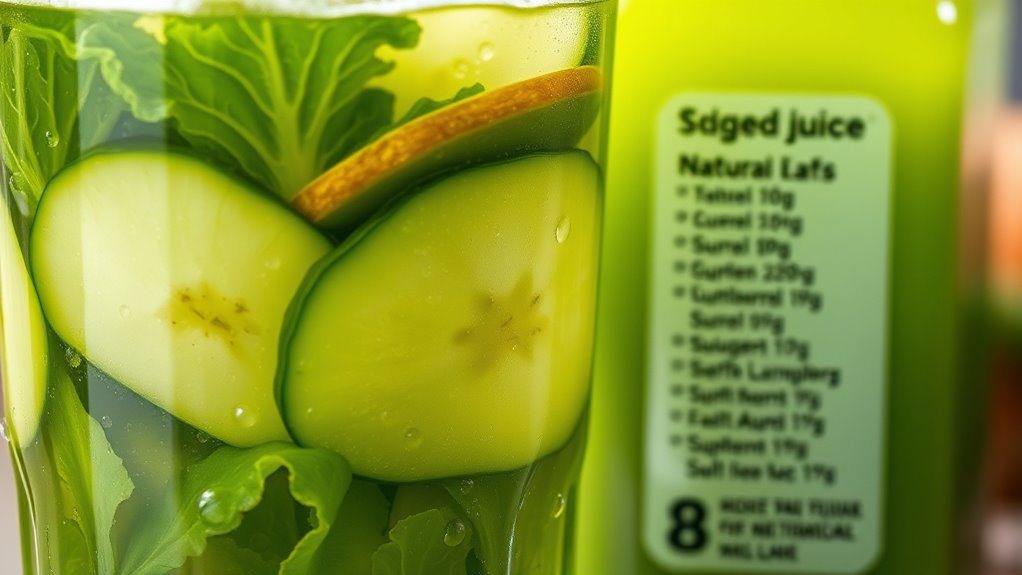
You can quickly identify sugary additions in green juices by paying attention to the ingredients list and labels. Look for ingredient substitutions like honey, agave, or fruit concentrates, which are often added for taste enhancement. These hidden sugars can be disguised, so scanning labels is key. To help you spot them instantly, consider this quick reference:
| Ingredient Type | Common Names | Purpose |
|---|---|---|
| Natural Sweeteners | Honey, agave nectar | Taste enhancement |
| Fruit Concentrates | Apple, pear, or grape juice | Flavor boost |
| Added Sugars | Cane sugar, high fructose corn syrup | Sweetening |
Focusing on these clues saves time and keeps your juice healthy, avoiding unnecessary sugar intake. Understanding ingredient labels can further empower you to make healthier choices quickly.
Frequently Asked Questions
Are There Any Artificial Sweeteners Hidden in Green Juices?
You might wonder if green juices contain artificial sweeteners. Some brands add artificial sweeteners or natural flavorings to enhance taste without extra sugar. Always check labels carefully, as these additives can be hidden ingredients. Opt for juices with minimal ingredients and no artificial or natural flavorings. By reading labels, you guarantee your green juice remains healthy and free from unwanted artificial sweeteners that could compromise your wellness goals.
Can “Sugar-Free” Labels Still Mean Hidden Sugars?
You might wonder if “sugar-free” labels hide label deception, but they often mean no added sugars. However, some products still contain hidden sugars from natural sweetness in ingredients like fruit concentrates or sweeteners. Always read the ingredient list carefully, as “sugar-free” doesn’t guarantee the absence of natural sugars or other sweeteners. Being vigilant helps you avoid hidden sugars and makes healthier choices.
How Do Processing Methods Affect Sugar Content in Juices?
Think of processing methods like a double-edged sword. Juice pasteurization heats the liquid, sometimes increasing sugar perception, while filtration techniques can strip out pulp but leave behind added sugars or concentrate them. These processes can alter the natural sugar content, making juices seem healthier than they are. So, when choosing a juice, know that processing impacts sugar levels, and a “healthy” label isn’t always the full story.
Are Organic Green Juices Less Likely to Contain Hidden Sugars?
Organic green juices are generally less likely to contain hidden sugars because organic certification requires ingredient transparency. When you choose organic, you’re more likely to see clear labels that list only natural ingredients without added sugars or artificial sweeteners. This transparency helps you make healthier choices and avoid sneaky sugars. Always check labels carefully, even with organic options, to guarantee you’re selecting a juice that aligns with your health goals.
What Are the Health Risks of Consuming Hidden Sugars Regularly?
Did you know that consuming too much sugar increases your risk of metabolic health problems by over 50%? Regular intake of hidden sugars can lead to weight gain, insulin resistance, and dental issues. These risks threaten your overall health, making it essential to read labels carefully and limit added sugars. By doing so, you protect your body from long-term damage and maintain better metabolic and dental health.
Conclusion
Now that you know the sneaky names and tricks to spot hidden sugars, you’re practically a juice detective! With just a quick glance, you can dodge sugar traps that could turn your healthy green juice into a sugar bomb. No more falling for misleading labels or fruit concentrate tricks. Arm yourself with these tips, and stay alert—because one sip of a “healthy” juice shouldn’t feel like a sugar shock to your system!

